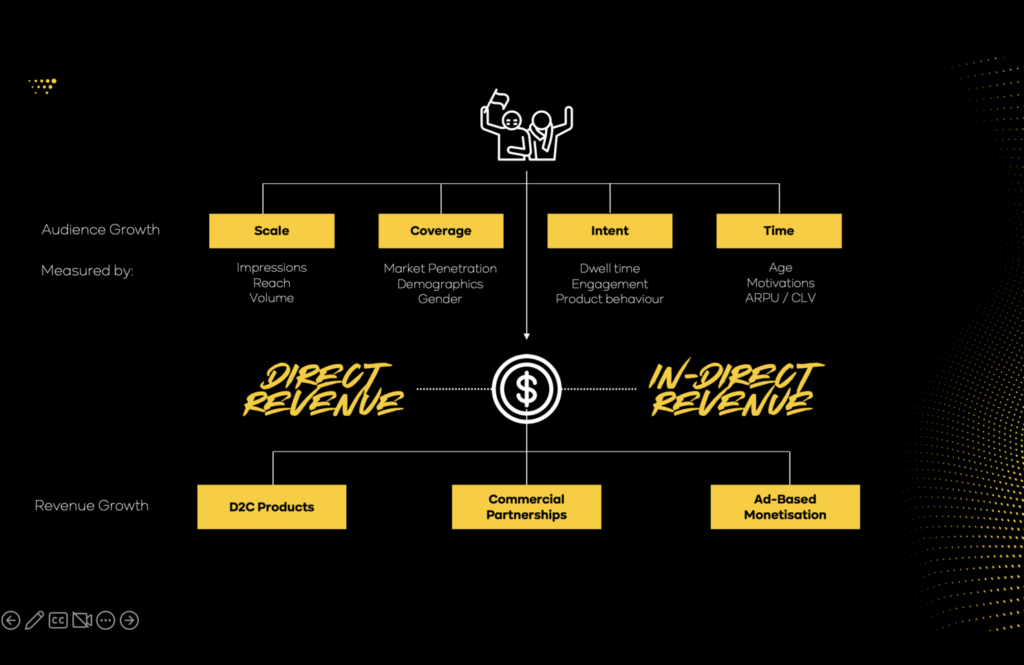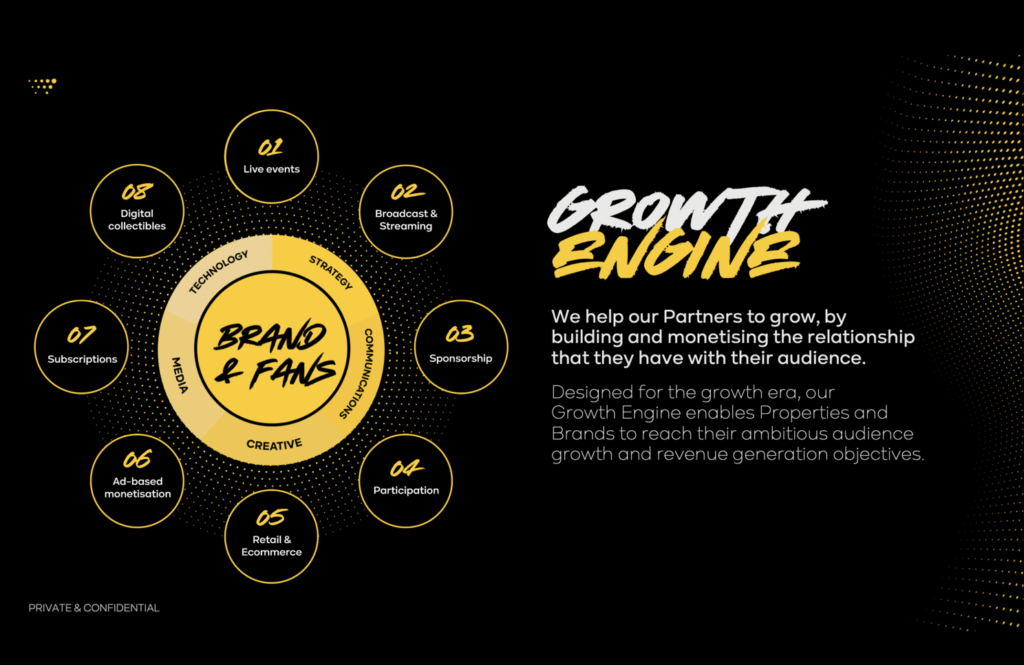
Taking control of growth: a mission statement for 2023
Every new year starts with possibilities but the one ahead is also marked with change and serious challenges for the sports and entertainment industry.
Brands that can identify, understand and capitalise on their own potential for growth will be best placed to weather the storm and even thrive in the era to come.
Economic news is always abstract – until it’s not.
Many of us will have a crystallising experience about what lies ahead. There will be a point where it all gets real.
For me, the severity of what is looming has really set in recently as I’ve watched talented people lose their jobs. Friends have reached out for work after years of stable employment. Social media is awash with difficult, personal posts from those already caught in a wave of redundancies.
If it isn’t here already, this economic pain will be coming for the sports industry very soon.
Related sectors are already feeling it, with tech giants like Meta laying off thousands of workers and media groups like Discovery Warner Bros and The Walt Disney Company making big financial corrections.
These decisions might have long-term strategic roots. But problems are being solved with cuts, instead of borrowing or fundraises, because loans are more expensive, and investors are naturally far more cautious.
In other words, easy cash is much harder to come by.
This is a real problem for parts of the sports industry. Too much of sport is still far too reliant on external funding over which it has too little control.
The shortfalls of the pandemic shutdown were an early warning, but a bigger shock is on its way.
Fundamentally, sport needs to become the master of its own growth.
Instead of focusing on long-term sustainable business ventures, many actors in our industry are always hunting the next windfall: a new entrant in the media rights marketplace, the latest lightly regulated sponsor, a sovereign wealth fund, or a deep-pocketed investor.
It would be nice to offer some optimistic sentiments here about sport’s inspirational qualities and its special place in our culture. But it wouldn’t be honest.
This is a business, and it faces the same challenges as everything else.
In these difficult conditions, business leaders must evoke both confidence and expertise to show how they are taking steps to deliver an economic impact.
In my world, the agency game, it’s critical to have the self-awareness to recognise that in an economic downturn like the one we are all facing, the early reductions (from a client’s budget) will impact those who are not affecting or enabling the economic growth of our client’s businesses.
We’ve seen over the past decade how technology has been democratising every function of marketing and advertising.
- Communication-based tasks such as PR, community management, and content creation can be completely in-housed.
- Product development can be offshored to less expensive markets.
- Technical services such as paid media, SEO, market research, business intelligence, and analytics are powered by platforms that are largely self-serve.
- And the growth of Linkedin has made sourcing and recruiting top talent easier than ever.
Agencies are under persistent threat.
Let’s be honest; likes, comments, shares, video views, and fast-moving colourful pictures won’t be enough to impress your clients’ CFO when the shit hits the fan.
Therefore, as well as offering experience, ideas, knowledge, and resources, we (agencies) must also be able to drive incremental economic growth for our clients.
Economic growth is the only thing that matters to a business.
Enabling this growth is therefore the only game.
Earlier this year, after six months in the trenches working on a refined positioning, inspired by a renewed purpose and vision, WePlay unveiled a new brand identity as a Growth Marketing Agency.
The first of its kind in our industry.
As fun as it is to tinker with fonts and colour palettes, this wasn’t just about showing a fresh face to the industry.
It was about capturing what we deeply believed a post-pandemic sports industry would look like and importantly, what it would take for the sports economy to thrive.
Sport’s most prized asset: its audience, and their attention
You will have heard this before: sport is unlike any other industry.
Sport captures more attention globally than any other industry.
This attention is an incredibly powerful currency.
However, across our entire industry, sports fan attention is commercially under-exploited.
This is predominantly due to the fact that while many sports brands have highly engaged audiences, fuelled by live events and emotive storytelling, few have a strategy for converting engagement into action.
Here lies the opportunity.
The untapped commercial value of the sports audience
We know that the brands that are winning big in this game and are producing year-on-year revenue growth, are the brands that understand their audience the best.
We’re able to see this as we peek through the shop window of their marketing output.
What you can’t see is that these brands have undertaken strategic and analytical work to distinguish both who their audience is, and what is its commercial value.
For some, this process may be complicated. So let’s make it uncomplicated.
Defining the value of your audience ahead of monetisation
At WePlay, our process for defining the value of an audience is four-fold:
- Define the Scale – we can measure this through a variety of metrics, like impressions, reach, and the overall audience volume across digital and linear channels
- Understand the Coverage – measured by geography and market penetration, demographics, and gender
- Determine the Intent – measured by important engagement metrics such as dwell time, watch time, time on site, average pages per visit, click-throughs, and conversion rates
- Time (lifetime) – measured by the age of your audience, their motivations and reasons to engage with you, the average revenue per user (ARPU), and the customer lifetime value (CLV)
This critical information is used not only to identify the current and future commercial value of your audience but also for forecasting exercises, such as Demand Generation.
Setting objectives for increased audience and revenue growth
Once we’ve got this information to hand, we can focus on two growth objectives.
- Audience Development – increasing each of the four core metrics above: scale, coverage, intent, and time
- Audience Monetisation – activating new and existing audiences to generate more revenue, improve efficiencies, and reduce overall OPEX
It is time to monetise: Introducing the Growth Engine
With a commercially viable audience, revenue generation can be accelerated – provided you have a viable model.
The WePlay “Growth Engine” is a commercial marketing model that we designed exclusively for the sports and entertainment industry.
It enables brands to accelerate the growth and monetisation of their audience.
In its most simplistic form, the Growth Engine is about outputs and outcomes.
Outputs and Outcomes
The outputs are the services that we (WePlay and our clients) deploy to engage with the target audiences.
We act as a marketing extension to our clients, wrapping around their commercial and marketing teams, and powering them with knowledge, expertise, and insights.
It’s a collaborative approach. We’re sometimes even white-labelled as their internal team.
We deploy our full-service provision of strategy (and business intelligence), communications, creative production, media planning & buying, and technology to turbo-charge audience engagement, which is then primed for monetisation.
This isn’t a vanity exercise either. An engaged fan, which is someone who visits your website, signs up for a mailing list, follows you on social media, or has interacted with your content, is TWICE as likely to buy from you versus someone who is not engaged.
Furthermore, an engaged fan also spends twice as much money.
An engaged audience is not only twice as likely to buy from you, they also spend twice as much money.
Now we have our audience primed. Our next step is to activate.
Across a plethora of channels – from organic social, paid social, PR, and influencer, to organic and paid search, programmatic, editorial, email and analytics – our output deployment utilises the full strength of today’s modern marketing mix.
It is designed to guarantee that our engaged audiences receive the right message, at the right time, on the channel they’re most likely to engage with us on.
The outcomes are then defined as where the action/transaction takes place:
- A ticket or hospitality sale
- A streaming subscription or PPV purchase
- Engagement with a sponsor
- Registering to take part in an event (running, swimming, cycling, or triathlon)
- Buying a retail product from a store
- Engaging with digital advertisements
- Purchasing a membership
- Downloading an app
- Signing up to a mailing list
- Buying a collectible
As mentioned earlier, the brands that are winning at this game are able to monetise their audiences across each of these verticals, year-round.
Don’t worry if you do not have an active strategy for the monetisation of your audience right now.
Rome wasn’t built in a day. It takes time to create great things.
You can also accelerate this process by contacting WePlay. ☺️
So, if you have gotten this far, you may be wondering what the main takeaway is.
It is this.
If you are a brand and you have an engaged audience, or you have the capability to build an engaged audience – then you have the opportunity right now to generate increased revenues and profits for your business.
And while this is a remit that WePlay is known for, I believe that the plethora of great marketing agencies in our industry also have a crucial role to play in enabling the economic growth of our industry.




